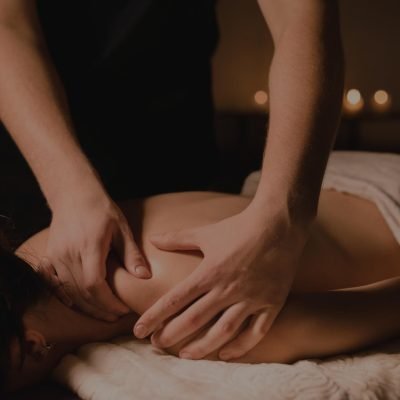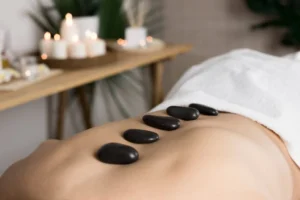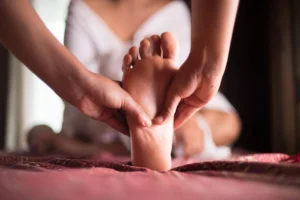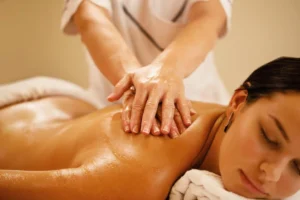
Are you looking for a gift that combines romance with genuine relaxation? A couples massage as a gift is more than an ordinary present—it is
Massage treatments are associated with deep relaxation, release, and pleasure. It’s no wonder, then, that many people are surprised when unpleasant discomfort appears in their bodies a day or two after their visit. However, it’s important to know that muscle soreness after a massage doesn’t necessarily mean something has gone wrong. In fact, it’s the body’s natural response to intense tissue work. In this article, we’ll discuss the most common causes of pain after massage and advise when it’s not worth worrying and when it’s best to consult a therapist.
Back pain after a massage can stem from many causes. Primarily, it’s the type of technique used. Deep tissue work causes micro-tears in the muscle structure, similar to those that occur after intense physical activity. The body interprets this stimulus as a signal to regenerate, resulting in a feeling of tension and sometimes tenderness. This is especially true in areas that were previously overworked, tense, or rarely used. Therefore, pain should not be interpreted as an error on the part of the massage therapist – on the contrary, it is often evidence that the treatment was effective.
Although it sounds alarming, minor inflammation after a massage is a natural reaction of the body, similar to that after an intense workout. During a massage, blood circulation improves, and tissues are greatly stimulated. Increased blood flow leads to increased nutrient transport and repair processes. Symptoms may resemble minor trauma: localized redness, slight swelling, or tenderness to touch. Such symptoms usually subside within 48 hours and do not require intervention. However, it is important to monitor your body – if the pain worsens overnight or is accompanied by other disturbing symptoms, it is worth consulting a specialist.
The gym isn’t the only place that can cause soreness. People who opt for a deep tissue massage or sports massage often experience symptoms similar to those after an intense workout. Soreness after a back massage is simply a delayed muscle reaction to micro-injuries caused by stretching and compression. This process can result in a feeling of stiffness, difficulty with full range of motion, and moderate pain. Symptoms typically subside after 2-3 days and do not impact overall health. Moreover, after recovery, many people notice improved posture, greater freedom of movement, and a reduction in chronic tension.
Can muscles ache after a massage? This is one of the most frequently asked questions in massage salons. The answer is yes – it’s normal, especially after the first treatment or after a longer break. The body needs time to adapt to the intense manual work. Pain typically peaks after about 24 hours and then gradually subsides. Discomfort is rare with relaxation massages, but with deep-tissue techniques, it’s completely natural.
The most common symptoms after massage include:

Mild bruising after a deep tissue massage is possible, especially if your skin is prone to broken capillaries or the massage was particularly intense. This is due to the rupture of small blood vessels located just below the skin’s surface. Bruising does not indicate improper treatment – it is the result of manual work and contact with tissues deeper than during a traditional massage.
Sometimes, instead of the expected relief, patients experience more intense pain immediately after the massage. The feeling that the pain is more intense after the massage may result from the intense stimulation of sensory receptors or the release of deeply rooted tension. This is a temporary phenomenon – after several hours, the muscles begin to regenerate, and the discomfort subsides. During this time, it is advisable to avoid intense physical activity, ensure hydration, and allow the body to rest.
Both pain after Thai massage and pain after fascial massage can be felt more intensely than after traditional massages. Thai massage works not only with muscles but also with pressure points, fascia, and joints. Stretching movements, foot pressure, and levers can trigger a strong response from the body, especially in those with tension in the lower back or neck. Fascial massage, on the other hand, directly affects the elasticity of the connective tissue and can cause short-term pain in areas of adhesions or restricted movement. In both cases, the body’s reaction is natural, and the long-term effect significantly improves your quality of life.
Want to understand whether post-massage pain is normal for you? Schedule a consultation at Lumira SPA – our therapists will clarify any concerns and tailor the treatment to your health condition. If you want to avoid post-massage pain, it’s also worth discussing the proper technique and body preparation for the treatment. At Lumira, we offer a variety of massages – from classic to deep – tailored to your needs and expectations.

Lumira Spa is a place where relaxation takes on a unique dimension. Experienced therapists from Asia offer signature rituals and massages inspired by Thai and Balinese traditions. Each of them honed their skills at prestigious schools in the Philippines and under the guidance of masters, combining their knowledge with over a decade of practice. Guests can enjoy massages, scrubs, and baths that nurture the body, mind, and spirit. The spa provides a comfortable and soothing atmosphere for both individual and paired experiences.

Are you looking for a gift that combines romance with genuine relaxation? A couples massage as a gift is more than an ordinary present—it is

Pregnancy is a time when a woman’s body undergoes significant changes – the spine is under increased strain, legs may swell, and muscles often become

Therapeutic massage is one of the oldest therapeutic methods, which has evolved over the centuries, becoming today an integral part of physiotherapy and rehabilitation. This

Hot stone massage is one of the oldest relaxation techniques, combining the power of touch with the natural warmth of lava stones. This unique form

Regular care for health and well-being increasingly includes natural methods of supporting the body. One such practice is reflexology, a special form of bodywork that

Balinese Massage – Origins, Philosophy, and Benefits Balinese massage is one of the most recognizable relaxation techniques, originating from traditional Indonesian medicine. This unique therapeutic